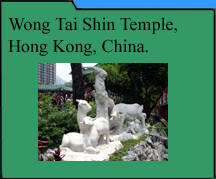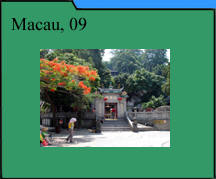back to Gallery Mainpage
Taoism
Taoism is a religious-philosophical
tradition that has, along with Confucianism, shaped East Asian
life for more than 2000 years. Philosophical Taoism is focused
upon the Tao- a natural way of all things that flows through every
sentient object and the universe itself. The most common illustration
of Taoist belief is the circular Yin Yang figure, which signifies
the balance of complementary opposites (shadow or receptivity
and light or proactivity). When these facets of life are in harmony,
health and well-being are nurtured. Thus, the overarching goal
of Daoism is to cultivate and balance these energies, and by doing
so, to achieve happiness through an embrace of the simplicity
and purity of the Dao. The original source of Daoism is said to
be the ancient I Ching, or Book of Changes-a work that offers
insights about the principles of the cosmos. Lao-tzu (a 6th century
B.C.E. scholar who wrote the Tao-te Ching, a book that poetically
approaches the Dao) and Chuang-tzu (a 4th century B.C.E. scholar
who urged individuals to comprehend the course of nature's change
and embrace the rhythms of life and death) are the most prominent
Daoist sages. However, the tradition also developed a more formal
religious component around the 2nd century C.E. which consists
of organized doctrines, religious practices, and institutional
leadership. Some within this subgroup believe that spirits (both
malevolent and benevolent) pervade nature and an elaborate pantheon
has developed. Also important for religious Daoism are the lives
of immortals (hsien) who protect those in harmony with the Dao.
Over the past two millennia, Daoism has often been hybridized
with Confucianism, Buddhism, indigenous forms of shamanism and
other Eastern religions. Therefore, one sometimes finds an intricate
melding of these traditions at temples and shrines throughout
East Asia.
In the realm of health, all
Daoists idealize a simple and harmonious lifestyle which seeks
to achieve holism through the balancing of yin and yang. Religious
Daoists may also practice magic and supplication to deities related
to cultural heroes and native powers in order to promote health
and prosperity. A key Daoist concept is wu-wei, or action through
inaction. This doctrine urges adherents to harmonize their actions
with the flow of life and the natural order of things. Longevity
(and even spiritual immortality) is an overarching concern for
some Daoists. Macrobiotic cooking, gymnastics, massage, acupuncture, herbalism, meditation, and martial arts that cultivate vital energy
(qi) are important techniques related to health. Daoism generally
places less emphasis upon individual moral duties, community standards,
and governmental responsibilities than on harmony with nature
and the Dao. However, in the arena of social health, practitioners
have urged individual freedom and self-transformation premised
upon creating an enduring and stable social order in which life
mirrors the harmony of the Dao.
In this section of the
Gallery, you will find images from two Daoist temples and a social
service agency. The Pak Tai Temple on Cheung Chau Island, China,
pays homage to a sea and fishing guardian. Some visitors view
Pak Tai as a military god who is invoked to bring peace to the
world. Community-wide health is also facilitated each spring through
the Bun Festival-an event designed to placate ghosts of locals
massacred by pirates or who died at sea. The Wong Tai Sin Temple
in Hong Kong, China, demonstrates the syncretic nature of Daoism
by hosting an altar for the three sages (Confucius, the Buddha,
and Lao-tzu). It devotes special attention to Wong Tai Sin, an
immortal shepherd. According to one legend, he was taught by an
another immortal to refine cinnabar into a medicine capable of
curing all illnesses and achieved fame as a healer after forty
years of perfecting this technique. This temple is also an important
site for fortune telling, with thousands of people visiting to
inquire about all facets of health and well being. Finally, the
Tam Centre for Hospice Care in Hong Kong offers bereavement counseling
and educational resources by linking traditional concepts of well-being,
such as Daoism, with social services and psychotherapy. Its butterfly
mural signifies transformation through grief and the opportunity
to grow via experiences of suffering.
A Ma Temple, built in 1488,
is one of the oldest and most famous temples in Macau. It is
influenced by Daoism, Buddhism, and local Chinese cultural
beliefs that are not limited to either religion. Indeed, this
temple may be considered Buddhist. I included it in the Daoism
section because of the predominance of deities for good fortune.
This temple is dedicated to the seafarers' goddess, A Ma (also
known as Tin Hau, Mazu, and Lin Mo). According to one legend, A
Ma was a poor girl looking for passage to Canton. She was
refused by the wealthy ship owners, but a fisherman took her on
board. A storm wrecked all but the boat carrying the girl. On
arrival in Macau she vanished, to reappear as a goddess at the
place where the fishermen built her temple. She is believed to
have been an exceptionally intelligent girl who could predict
people's fortunes. As a goddess, she helps merchants and
fishermen to prevent calamities and obtain good fortune. This
temple also features Kwan Yum (Avalokitesvara), the Buddhist
Bodhisattva of Compassion, and various deities for good fortune.





